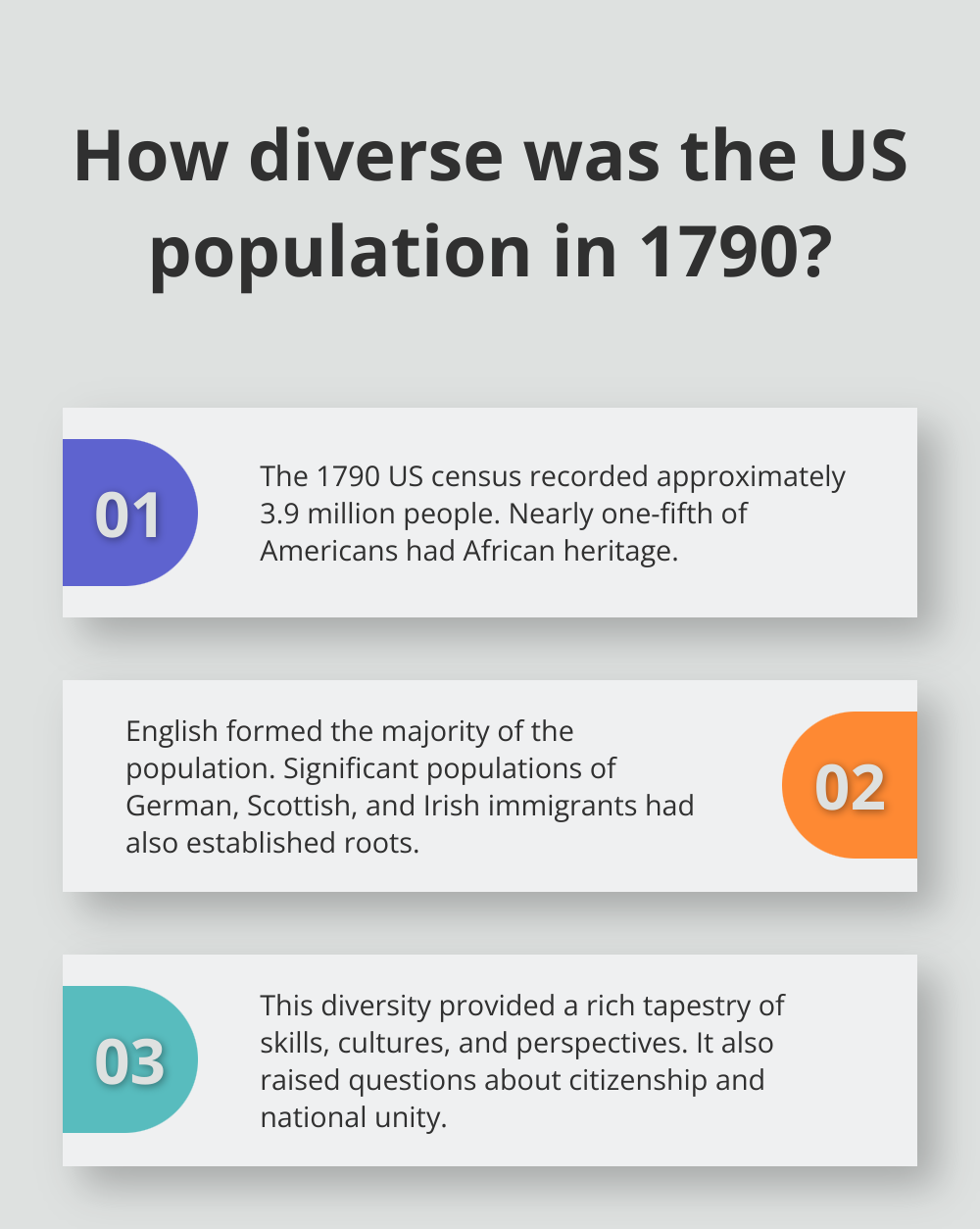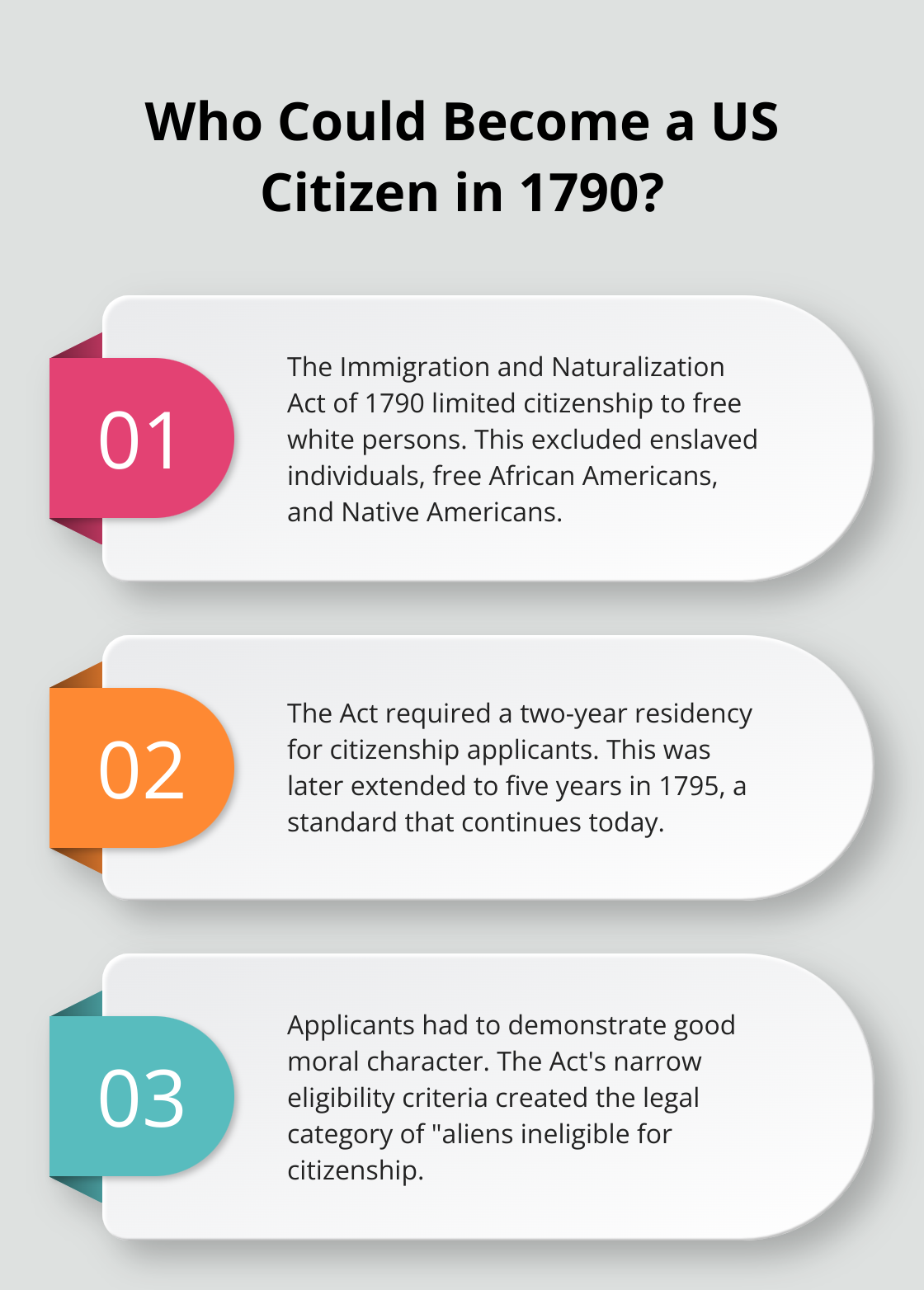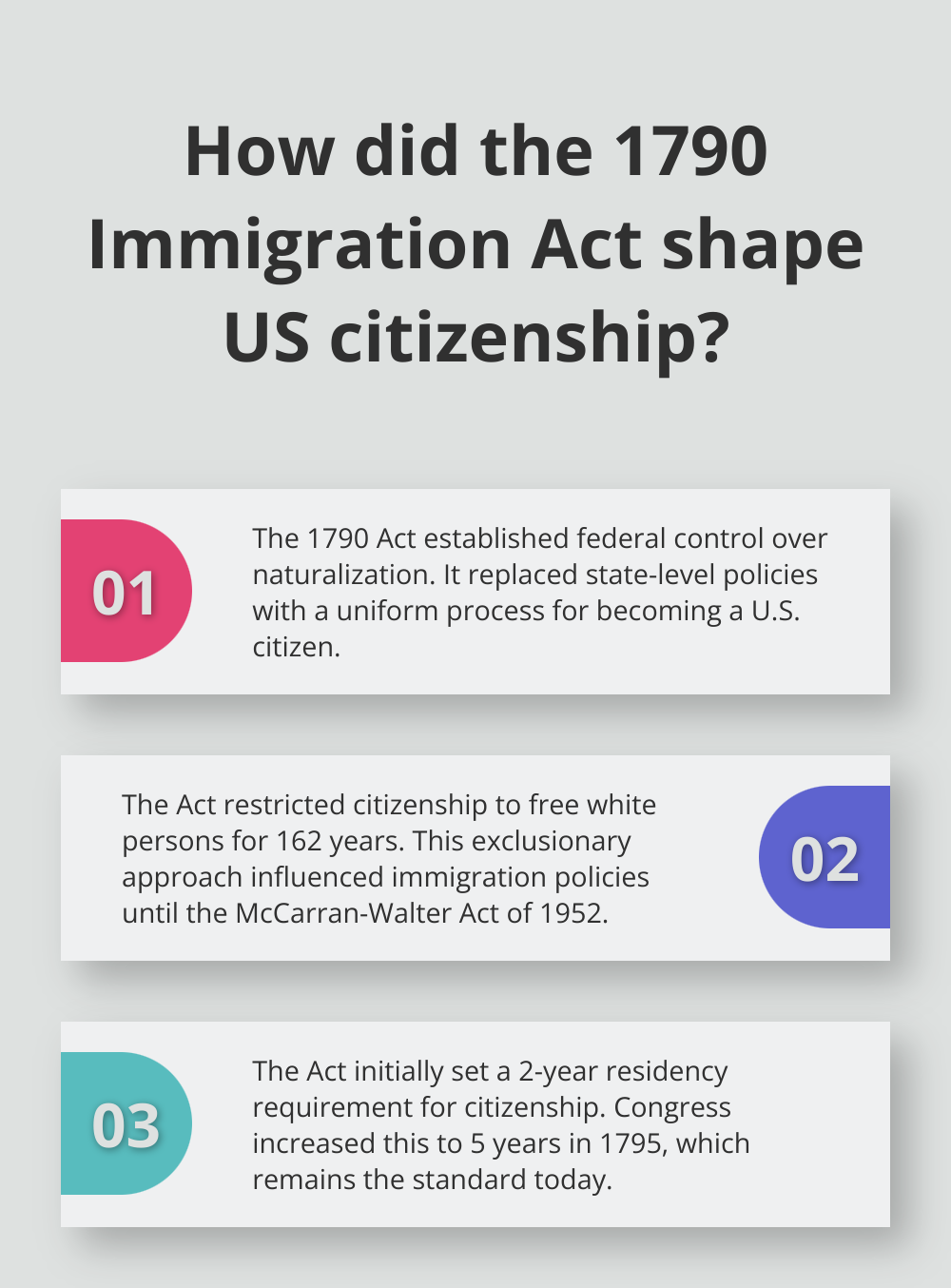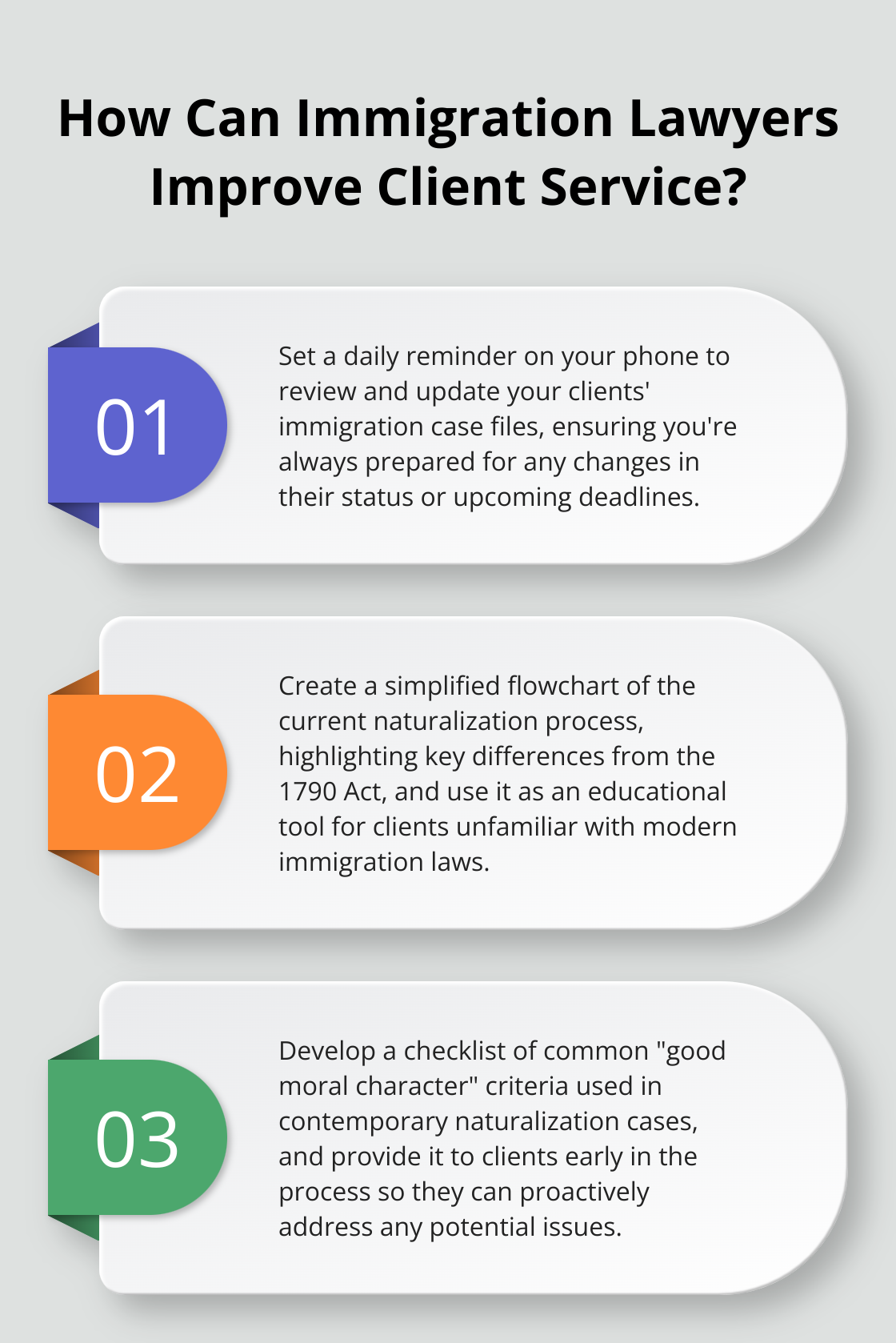
Immigration and Naturalization Act of 1790: A History
The Immigration and Naturalization Act of 1790 marks a pivotal moment in American history, shaping the nation’s approach to citizenship and immigration for generations to come.
At Law Offices of Jeffrey A. Thompson, we recognize the enduring impact of this groundbreaking legislation on our clients and the broader American society.
This post explores the historical context, key provisions, and lasting legacy of this foundational act, shedding light on its role in defining American identity and immigration policy.
A Nation in Flux: Post-Revolutionary America
The Demographic Landscape of 1790
The United States in 1790 presented a more diverse picture than many might expect. The first U.S. census that year recorded approximately 3.9 million people. While the English formed the majority, nearly one-fifth of Americans had African heritage. Significant populations of German, Scottish, and Irish immigrants had also established roots in the new nation.

This diversity offered both opportunities and challenges for the young republic. It provided a rich tapestry of skills, cultures, and perspectives that could contribute to the nation’s growth. However, it also raised questions about citizenship and national unity amidst varied backgrounds.
The Patchwork of State Policies
Before 1790, naturalization fell under the purview of individual states, resulting in inconsistent policies. Some states adopted lenient approaches, while others maintained stricter requirements. This fragmented system proved unsustainable for a nation seeking to establish itself on the global stage.
The Constitution’s framers recognized the need for a unified approach to citizenship. Article I, Section 8, Clause 4 explicitly granted Congress the power to establish a uniform rule of naturalization. This provision laid the groundwork for the Immigration and Naturalization Act of 1790, which would become the first federal law addressing citizenship in the United States.
Balancing Openness and Exclusion
The Act of 1790 emerged from a complex set of motivations and concerns. On one hand, there was a desire to encourage immigration to help populate and develop the vast territories of the new nation. Many viewed immigrants as a valuable source of labor and skills that could contribute to economic growth.
However, this openness faced opposition from fears of foreign influence and a desire to maintain a particular vision of American identity. The debates surrounding the Act reflected deep-seated anxieties about loyalty, assimilation, and the preservation of what were seen as core American values.
Setting Precedents for the Future
The Immigration and Naturalization Act of 1790 was not just a piece of legislation; it was a statement about who could belong in the new American nation. Its provisions would have far-reaching consequences, setting precedents that would influence immigration policy for centuries to come.
As we move forward to examine the key provisions of the Act, we will uncover how these early decisions shaped the foundation of American citizenship and continue to resonate in modern immigration debates.
Who Could Become an American Citizen?
The Immigration and Naturalization Act of 1790 established clear and restrictive criteria for naturalization in the United States. This landmark legislation created a framework that would influence American immigration policy for decades to come.
The Narrow Path to Citizenship
The Act limited eligibility for naturalization to free white persons of good character. This requirement excluded a significant portion of the population, including enslaved individuals, free African Americans, and Native Americans. (The racial restrictions imposed by this Act remained in place until the McCarran-Walter Act of 1952, over 160 years later.)

The Act also mandated a two-year residency requirement for citizenship applicants. This provision aimed to ensure that immigrants had sufficient time to acclimate to American society and demonstrate their commitment to their new home. However, Congress extended the residency period to five years in 1795, a standard that continues today.
The Good Character Clause
One of the more subjective requirements of the 1790 Act was the demonstration of good moral character. While this clause remains part of modern naturalization law, its interpretation has changed significantly over time. In the late 18th century, good character often implied political loyalty to the new republic and adherence to prevailing social norms.
Exclusions and Limitations
The Act’s narrow definition of eligibility had far-reaching consequences. It created a legal category known as “aliens ineligible for citizenship”, which significantly impacted the rights of many immigrants, particularly those from Asia. Asian immigrants remained in this category until 1952. Noncitizens faced restrictions on property ownership, legal representation, public employment, and voting rights.
Moreover, the Act’s provisions for citizenship extended to the children of naturalized citizens residing in the U.S. under 21 years of age. This aspect of the law laid the groundwork for future debates about birthright citizenship and the status of children born to noncitizen parents.
Impact on Future Generations
The Immigration and Naturalization Act of 1790 reflected the complex interplay of ideals and prejudices that characterized early American society. While it established a uniform federal policy on naturalization, it also codified exclusionary practices that would shape American immigration law for generations.
As we examine the impact and legacy of the 1790 Act in the next section, we will uncover how these early decisions continue to resonate in modern immigration debates and policy-making.
How the 1790 Act Shaped American Immigration
Federal Control over Naturalization
The Immigration and Naturalization Act of 1790 established the foundation for federal control over naturalization. This landmark legislation created a uniform process for becoming a U.S. citizen, which replaced the previous patchwork of state-level policies that governed naturalization.
A History of Exclusion
The Act’s restrictive eligibility criteria produced far-reaching consequences. The limitation of citizenship to free white persons effectively barred a significant portion of the population from full participation in American society. This exclusionary approach influenced subsequent immigration policies for over 160 years, which shaped the demographic makeup of the United States.

The racial restrictions imposed by the 1790 Act remained in place until the McCarran-Walter Act of 1952 eliminated them. This law repealed the last of the existing measures to exclude Asian immigration, allotted each Asian nation a minimum quota of 100 visas each year. During this period, numerous immigrant groups faced significant barriers to citizenship and the rights it conferred. For instance, the Chinese Exclusion Act of 1882 specifically targeted Chinese immigrants, prohibited their naturalization, and severely restricted their entry into the country.
Changes in Residency Requirements
The Act initially set a two-year residency requirement for citizenship applicants. Congress increased this to five years in 1795 (a standard that remains in place today). This change reflected growing concerns about the assimilation of immigrants and their loyalty to the new nation. The residency requirement continues to serve as a key aspect of the naturalization process, which impacts millions of immigrants who seek U.S. citizenship.
Contemporary Debates and Reforms
The legacy of the 1790 Act continues to influence contemporary immigration debates. Issues such as birthright citizenship (which stems from the Act’s provisions for children of naturalized citizens) remain contentious topics in American politics. The concept of good moral character, introduced in the 1790 Act, still serves as a requirement for naturalization, though its interpretation has evolved significantly over time.
The Immigration and Naturalization Act of 1790 set the stage for over two centuries of immigration policy in the United States. Its impact on American society, demographics, and national identity cannot receive overstatement. As we continue to debate and refine our approach to immigration, we must understand the historical context that has brought us to where we are today.
Final Thoughts
The Immigration and Naturalization Act of 1790 established federal control over citizenship and set a precedent for exclusionary practices in U.S. immigration policy. This landmark legislation limited citizenship to “free white persons,” a restriction that persisted for over 160 years until its elimination by the McCarran-Walter Act of 1952. Subsequent laws, such as the Immigration and Nationality Act of 1965, transformed the landscape by abolishing national-origin quotas and prioritizing family reunification and skilled labor.

The Act’s legacy continues to influence modern debates on immigration, including discussions about birthright citizenship and residency requirements. Its impact on American identity remains significant, shaping public discourse and policy decisions to this day. The complexities of current immigration law reflect the ongoing evolution of these historical foundations.
At Law Offices of Jeffrey A. Thompson, we understand the challenges posed by contemporary immigration policies. Our team specializes in guiding clients through the intricacies of the naturalization process, providing knowledgeable representation tailored to each individual’s situation. We strive to help our clients achieve their goals within the framework of current immigration laws.


